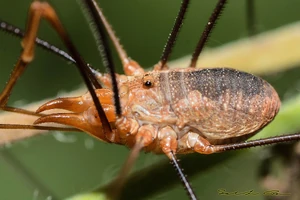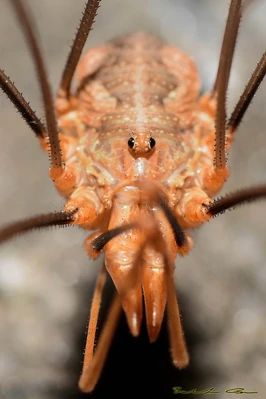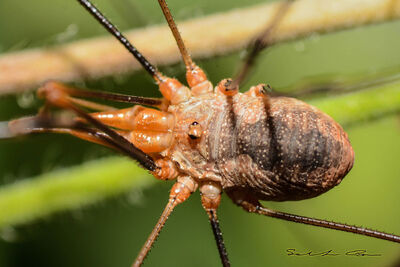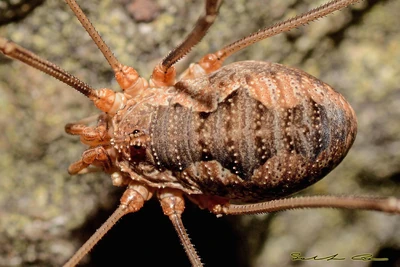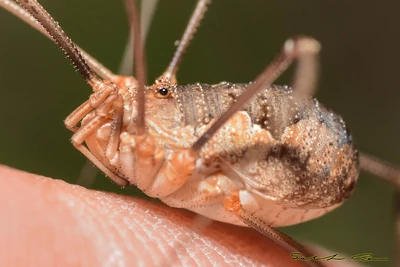Phalangium opilio Linnaeus, 1758 is a widespread species of Eupnoi. It is the first species of Opiliones described.
Abbreviated logonymy from WCO[]
• Phalangium opilio Linnaeus 1758: 618 [1].
• Phalangium cornutum Linnaeus 1767 [2]: 1028 [junior subjective synonym of Phalangium opilio Linnaeus, 1758 by Latreille (1798: 114), reaffirmed by Latreille (1804: 321) and many other authors, but with many subsequent inversions of precedence, see remarks below].
• Cerastoma curvicornis C.L. Koch 1839c: 30 [3] [junior subjective synonym of Phalangium cornutum Linnaeus, 1767 by Kraepelin (1896)].
• Cerastoma brevicornis C.L. Koch 1839c: 30 [junior subjective synonym of Phalangium opilio Linnaeus, 1758 by Kulczyński (1904)].
• Opilio molluscus L.Koch 1867b: 887 [junior subjective synonym of Phalangium opilio Linnaeus, 1758 by Roewer (1911e: 8)].
• Opilio praefectus L.Koch 1867b: 888 [junior subjective synonym of Phalangium opilio Linnaeus, 1758 by Roewer (1911e: 8)].
• Cerastoma tirolense L.Koch 1869: 157 [junior subjective synonym of Phalangium opilio Linnaeus, 1758 by Roewer (1911e: 8)].
• Cerastoma capricorne L.Koch 1869: 158; Wajgiel 1868: 155; Wajgiel 1874: 35; Nowicki 1874: xxx [junior subjective synonym of Phalangium opilio Linnaeus, 1758 by Roewer (1911e: 8)].
• Cerastoma dentatum C.L. Koch 1871: 77 [junior subjective synonym of Phalangium opilio Linnaeus, 1758 by Roewer (1911e: 8)].
• Phalangium longipalpus Weed 1890: 783 [junior subjective synonym of Phalangium opilio Linnaeus, 1758 by Roewer (1911e: 8)].
........................... to do
Taxonomy[]
Original description[]
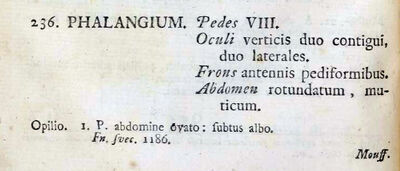
Phalangium and P. opilio, original description by Linnaeus 01
Phalangium opilio has been described in the same page as the genus Phalangium, with the short words: "Phalangium abdomine ovato: subtus albo." and "Habitat in Europa, America." There were two other species included in Phalangium: P. caudatum and P. reniforme, today included respectively in Thelyphonida and Amblypygi. The designation of P. opilio as type of Phalangium was only made much later, by Latreille in 1810.
Early depictions[]
Baron Charles De Geer (1778)[]
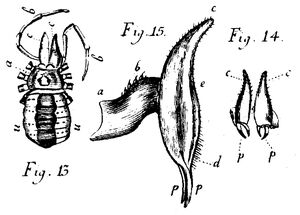
Phalangium cornutum, by de Geer (1778).
Phalangium cornutum: De Geer 1778: 173, plate 10, figs 12–15 (French vernacular “faucheur cornu”) [4].
This was the first depiction ever of this species, 20 years after its description, but still under the name of P. cornutum, a species described in 1767 based upon males. The Swedish/Dutch author De Geer clearly illustrated the chelicera of male in a most recognizable manner. He provided a short characterization in French (with a corresponding in Latin), and many comments about distribution.
"Faucheur à corps ovale d'un brun grîseâtre en dessus avec une bande noire & blanc en dessous, à très-long bras & à tenailles cornues."
Johann Friedrich Wilhelm Herbst (1798)[]
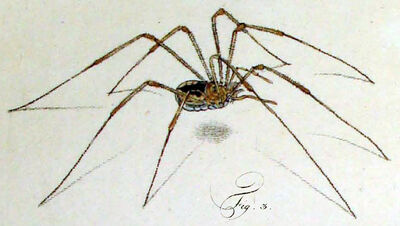
Opilio cornutus, male, by Herbst (1798).
Opilio cornutus: Herbst 1798: 13, pl. I, fig. 3 [5].
Another 20 years later the German entomologist Herbst gave descriptions with fine illustrations of the animals in mock-live stance. By them he considered Phalangium opilio to be the same as Opilio parietinus and O. cornutus was still the male of what we today call Phalangium opilio. As he despised the name Phalangium for the genus, he used Opilio instead.
19th Century[]
Carl Wilhelm Hahn (1835)[]
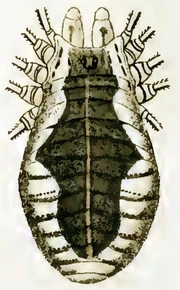
Phalangium opilio, female by Hahn (1835).
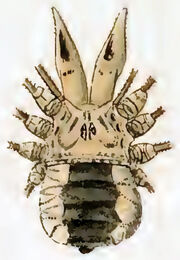
Phalangium opilio, male as P. cornutum by Hahn (1835)
Phalangium opilio: Hahn 1835: 67, pl. 69, figs 160a–f [6].
Hahn still followed the Linnean scheme in that he considered the female to be P. opilio and the male P. cornutum. This scheme persisted for many years. In this redescription, Hahn for the first time illustrated the species under this name. He still considered this species to be a synonym of P. parietinum and called it Mauer-Phalangium, which is a German translation of this name.
Phalangium cornutum: Hahn 1835: 68, pl. 70, figs 161a–f [6].
Hahn described and illustrated the males of P. opilio under this name, mistakenly recognizing "males" and "females" when they were all males. He also gave beautiful colored figures of structures.
Synonymy with inversion of precedence[]
Phalangium cornutum: junior subjective synonym of Phalangium opilio Linnaeus, 1758 (type of Phalangium): by Latreille (1798: 114, 1802a: 377). Synonym reaffirmed by Gray (1833: 501). Synonymy disclaimed: by Meade (1855: 399–401, 404), who believed (following Herbst 1798: 12) that P. opilio Linnaeus was Phalangium parietinum De Geer, 1778, now type of Opilio. Roewer (1912c: 91, 124), among others, followed Meade. All modern authors follow Thorell (1876: 486–490), Simon (1879b: 195) and Roewer (1923: 751–752) in reaffirming the synonymy [Crawford 1992: 14]. Gervais (1844) considered all three species, P. opilio, P. cornutum and P. parietinum to be synonyms.
Abbreviated geographic records from WCO[]
Belgium (Becker 1896)
Bulgaria (Roewer 1926b)
Canada (Hackman 1956)
China (Wang 1953)
Croatia (Hadži 1930)
Czech Republic (Bartoš 1941; Šilhavý 1940a; Šilhavý 1947)
Estonia (Grube 1859, Schenkel-Haas 1924; Staręga 1978)
France (Simon 1879b)
Georgia (Mkheidze 1959; Staręga 1966a)
Germany (De Geer 1778; C. Koch 1871)
Greece (Roewer 1959b; Rambla 1968a)
Hungary (Kolosváry 1933b)
Italy (Canestrini 1872d; Cantoni 1882b; Caporiacco 1922; Caporiacco 1923; Caporiacco 1934a; Caporiacco 1938c; Lerma 1952b; Pavesi 1878b; Roewer 1924d; Simon 1882a)
Latvia (Grube 1859; Tumss 1963)
Lithuania (Eichwald 1830)
Luxembourg (Muller 1962)
Mongolia (Roewer 1911e)
Morocco (Lépiney 1940)
Netherlands (De Geer 1778; Spoek 1963)
Norway (Fabricius 1780)
Poland (Grentzenberg 1896; Kulczyński 1876; Snegovaya & Staręga 2009; Wajgiel 1868; Wajgiel 1874)
Portugal (Bacelar 1928; Franganillo 1920; Kulczyński 1899; Schenkel 1938; Simon 1898b; Vieira 1893)
Romania (Cîrdei 1942b; Corti in Jaquet 1905)
Russia (Chemeris et al. 1998; Crawford 1996;Ermolajev 1937; Grese 1911b; L. Koch 1879b; Kulczyński 1901; Kulczyński 1913; Le Roi 1914; Mejer 1915; Roewer 1956; Schenkel-Haas 1925, 1928; Staręga 1978)
Slovakia (Bartoš 1939b)
Slovenia (Hadži 1930)
Spain (Cuní y Martorell 1889; Dufour 1831; Roewer 1925d; Simon 1884a)
Syria (Roewer 1911e)
Sweden (De Geer 1778; Tullgren 1906a)
Switzerland (Schenkel 1936b)
Turkey (Kurt et al. 2008a; Roewer 1959b; Roewer 1961a; Simon 1875b)
UK (Delany 1959)
Ukraine (Belke 1853; Bartoš 1939a; Chemeris & Kovblyuk 2005; Eichwald 1830; Wajgiel 1868, 1874, Morin 1931; Morin 1934; Nowicki 1869, L. Koch 1870; Staręga 1978; Nowicki 1874, Rosca 1930; Cîrdei 1960)
USA (Crosby 1907; Crosby 1911; Roewer 1911e)
Distribution[]
“All parts of Europe, North and Central Asia, Asia Minor, North Africa and North America.” [Spoek 1963[7]]. “Common Holarctic species, introduced in New Zealand.” [Staręga 1978[8]]. “Cosmopolitan. Far Eastern records include Hokkaido (Suzuki, Tsurusaki, 1983), Habomai and Kuril Islands north to Matua (unpublished), Moneron. Surprisingly this species is not yet known from the mainland Russian Far East, though common in central and western Siberia (Chemeris et al. 1998[9]).” [Crawford & Marusik 2007].
The word “cosmopolitan” is not accurate, as it is absent from northern Scandinavia, Greenland, Iceland, Afghanistan, Himalayas, Tropical Africa, Tropical America and Tropical Asia. A good summary of altitudinal distribution can be found in Martens (1978: 235).
References[]
- ↑ Linnaeus, C. (1758) Systema naturae per regna tria naturae, secundum classes, ordines, genera, species, cum characteribus, differentiis, synonymis, locis. Editio decima, reformata. Tomus 1. Laurentius Salvius, Holmiae [Stockholm], [iv] + 824 pp. [Issued 1 Jan 1758].
- ↑ Linnaeus, C. (1767) Systema naturae per regna tria naturae, secundum classes, ordines, genera, species, cum characteribus, differentiis, synonymis locis. Editio duodecima reformata. Tomus 1, pars 2. Laurentius Salvius, Stockholm, 533–1327 + [37] pp.
- ↑ Koch, C.L. (1839c) Übersicht des Arachnidensystems. Zweites Heft (of 5). Nürnberg: C. H. Zeh, Nürnberg, 38 pp., 6 pls. [Issued December 1839].
- ↑ De Geer, C. (1778) Des Faucheurs (pp 163–175, pl. 10). In: Mémoires pour servir à l'histoire des insectes. Tome 7. Pierre Hesselberg, Stockholm, xii + 950 pp., 49 pl.
- ↑ Herbst, J.F.W. (1798) Naturgeschichte der Insecten-Gattung Opilio. In: Natursystem der ungeflügelten Insekten, vol. 2 [of 4]. Gottlieb August Lange, Berlin, iv + 26 pp., 5 pls.
- ↑ 6.0 6.1 Hahn, C.W. (1835) Die Arachniden getreu nach der Natur abgebildet und beschrieben. 2 (6) [“1834”]. C. H. Zeh'schen Buchhandlung, Nürnberg, pp. 65–75, pls. LXVII–LXXII.
- ↑ Spoek, G.L. (1963) The Opilionida (Arachnida) of the Netherlands. Zoologische Verhandelingen, 63, 1–70.
- ↑ Staręga, W. (1978) Katalog der Weberknechte (Opiliones) der Sowjet-Union. Fragmenta Faunistica, 23 (10), 197–241.
- ↑ Chemeris, A.N., Logunov, D.V. & Tsurusaki, N. (1998) A contribution to the knowledge of the harvestman fauna of Siberia (Arachnida: Opiliones). Arthropoda selecta, 7, 189–199.
External links[]
Pierre Oger [1].
Gallery - additional images[]
| Eupnoi Classification |
|---|
| Incertae sedis | ||
|---|---|---|
| Not assigned to any family | †Brigantibunum | †Daohugopilio | †Macrogyion | Hesperopilio | |
| Superfamily Caddoidea | ||
|---|---|---|
| Family Caddidae | Caddo | |
